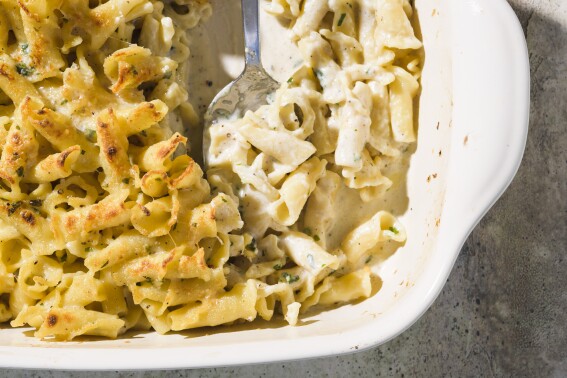Growing up in Southern Thailand, Nok Suntaranon spent most days after school helping her mother sell homemade curry pastes in the local market.
Dealing with customers. Pushing the heavy cart with her two brothers. Staining her fingers yellow as she peeled turmeric root by the kilo, enough for the 110 pounds of curry paste her mother sold every day.
Her mother needed the help. Suntaranon’s grandfather, who was helping to support the family, and her aunt were killed in a motorbike accident when she was just 4. Her mother was forced to become breadwinner overnight.
“We grew up poor, but when it comes to food, we never skimped,” Suntaranon said. “We always had the best food on our table.”
That her hardworking mother informed her cooking is apparent in the Philadelphia restaurant she named after her, Kalaya, and in her new book, “ Kalaya’s Southern Thai Kitchen.”
But Suntaranon’s mother didn’t teach her how to cook. Rather, the children would experiment with ingredients they bought at the market, earning money by selling banana leaves cut from the plantation in front of the family house.
“We learned how to light the fire on our own in the clay stove,” said Suntaranon, winner of a James Beard Award for best chef, Mid-Atlantic, in 2023. “We just liked to play cooking.”
Not until decades later did Suntaranon go to culinary school, after she had worked for 20 years as a flight attendant and met the husband who brought her to Philadelphia.
The more she learned about cooking, the more curious she became about her own cuisine, a study in contrasts suffused with the history of the spice trade. In her home region of Trang, fiery curries, springy noodles and soothing soups all can come laced with the warming flavors of cinnamon and star anise. Even jasmine rice is spiced with white pepper.
She recreated lost recipes from her grandmother and great-grandmother from memory, experimenting until the flavors reached the right balance between spicy and sweet, fragrant and bold. And of course, she documented all the dishes her mother used to make for her.
Such as her chicken soup. When Suntaranon was sick as a young girl, her mother made her an herbaceous soup that’s heavy on aromatics, vibrant yellow from earthy turmeric and freshened with a handful of cilantro. The homemade broth, which takes only as long as the chicken to cook, comes brightly spiced with lime and a full tablespoon of black and white peppers.
The turmeric, she said, boosts your immune system, and smashing the aromatics is great for releasing tension —“another way to heal your heart and restore your soul.”
Gai Tom Kamin, “My Mother’s Turmeric Chicken Soup for a Cold”
From “ Kalaya’s Southern Thai Kitchen ” by Nok Suntaranon, with Natalie Jesionka
Serves: 4 to 6
Time: About 45 minutes
Ingredients
Handful of fresh cilantro stems and leaves
1 large shallot, peeled and cut into small wedges
1⁄4 cup garlic cloves, smashed
2 fresh lemongrass stalks, ends trimmed, smashed
2 scallions, ends trimmed, smashed with a pestle or the smooth end of a meat mallet
1⁄2 tablespoon freshly ground black pepper
1⁄2 tablespoon ground white pepper
11⁄2 tablespoons kosher salt
2 bone-in, skin-on chicken thighs
2 chicken legs
1 tablespoon ground turmeric
3 tablespoons fish sauce
2 tablespoons sugar
FOR SERVING
Glass noodles (cooked according to the package directions) or Jasmine rice
Fresh cilantro leaves
Fried shallots, homemade or store-bought
Thinly sliced Thai chilies or red long hot chilies
Thinly sliced scallions
Lime wedges, for squeezing
Directions
In a large pot, combine 12 cups water, the cilantro, shallot, garlic, lemongrass, scallions, black pepper, white pepper, turmeric, salt and chicken. Bring to a boil over high, then reduce heat to medium-low and simmer until the chicken is tender, about 30 minutes.
Remove from the heat and stir in the fish sauce and sugar. You can remove the chicken and pull it off the bone into shreds, stirring it back into the broth, or serve it bone in.
Serve hot on its own or with glass noodles or rice, topped with cilantro, fried shallots, chiles, scallions and lime wedges.
EDITOR’S NOTE: Albert Stumm writes about food, travel and wellness. Find his work at https://www.albertstumm.com
Disclaimer: The copyright of this article belongs to the original author. Reposting this article is solely for the purpose of information dissemination and does not constitute any investment advice. If there is any infringement, please contact us immediately. We will make corrections or deletions as necessary. Thank you.



